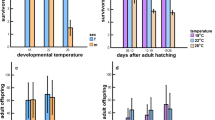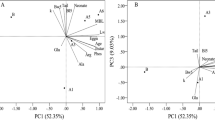Abstract
The distributional pattern of geographical parthenogenesis has not yet been clearly explained. In Daphnia pulex, asexuals are found at higher latitude and in more marginal habitats than their sexual relatives. In addition, some asexual lineages, especially northern ones, are polyploid. This study aimed to test if polyploid clones are more resistant than sympatric diploid clones to a wide range of environmental factors and if asexual Daphnia (diploid clones) are more tolerant of extreme environmental conditions than sexual ones. We report significant differences in survivorship after short-term exposure to acute pH, conductivities, and temperature in 12 lineages of the Daphnia pulex complex. Ploidy level, reproductive mode, geographic origin, and heterozygosity level had a significant effect on survival but their effect varied depending on environmental factors.

Similar content being viewed by others
References
Adamowicz SJ, Gregory TR, Marinone MC et al (2002) New insights into the distribution of polyploid Daphnia: the holarctic revisited and Argentina explored. Mol Ecol 11:1209–1217
Aguilera X, Mergeay J, Wollebrants A et al (2007) Asexuality and polyploidy in Daphnia from the tropical Andes. Limnol Oceanogr 52:2079–2088
Angers B, Schlosser IJ (2007) The origin of Phoxinus eos-neogaeus unisexual hybrids. Mol Ecol 16:4562–4571
Asker SE, Jerling L (1992) Apomixis in plants. CRC Press, Boca Raton
Baker HG (1955) Self-compatibility and establishment after ‘‘long-distance’’ dispersal. Evolution Int J org Evolution 9:347–348
Barata C, Hontoria F, Amat F et al (1996) Demographic parameters of sexual and parthenogenetic Artemia: temperature and strain effects. J Exp Mar Bio Ecol 196:329–340
Beaton MJ, Hebert PDN (1988) Geographical parthenogenesis and polyploidy in Daphnia pulex. Am Nat 132:837–845
Boersma MD (1999) Environmental stress and local adaptation in Daphnia magna. Limnol Oceanogr 44:393–402
Cuellar O (1994) Biogeography of parthenogenetic animals. Biogeographica 70:1–13
Doeringsfeld MR, Schlosser IJ et al (2004) Phenotypic consequences of genetic variation in a gynogenetic complex of Phoxinus eos-neogaeus clonal fish (Pisces:Cyprinidae) inhabiting a heterogeneous environment. Evolution Int J org Evolution 58(6):1261–1273
Dufresne F, Hebert PDN (1995) Polyploidy and clonal diversity in an arctic cladoceran. Heredity 75:45–53
Glesener RR, Tilman D (1978) Sexuality and the components of environmental uncertainty: clues from geographic parthenogenesis in terrestrial animals. Am Nat 112:659
Haag CR, Ebert D (2004) A new hypothesis to explain geographical parthenogenesis. Ann Zool Fenn 41:539–544
Hebert PDN, Finston TL (2001) Macrogeographic patterns of breeding system diversity in the Daphnia pulex group from the United States and Mexico. Heredity 87:153–161
Hebert PDN, Schwartz SS, Ward RD et al (1993) Macrogeographic patterns of breeding system diversity in the Daphnia pulex group. I. Breeding systems of Canadian populations. Heredity 70:148–161
Hrbacek J (1987) Systematics and biogeography of Daphnia species in the northern temperate region. Memorie Dell’ Istituto Italiano Di Idrobiologia 45:37–76
Innes DJ, Hebert PDN (1988) The origin and genetic basis of obligate parthenogenesis in Daphnia pulex. Evolution Int J org Evolution 42:1024–1035
Jose C, Hebert Chatelain E et al (2009) Low flexibility of metabolic capacity in subarctic and temperate cytotypes of Daphnia pulex. Journal of Thermal Biology 34(2):70–75
Kearney M (2005) Hybridization, glaciation and geographical parthenogenesis. Trends Ecol Evol 20:495–502
Lamatsch DK, Lampert KP, Fischer P et al. (2008) Diploid Amazon mollies (Poecilia formosa) show a higher fitness than triploid in clonal competition experiments. Evol Ecol. doi 10.1007/s10682-008-9264-2
Lewis WH (1980) Polyploidy: biological relevance. Plenum Press, New York
Licht LE, Bogart JP (1989) Embryonic-development and temperature tolerance in diploid and polyploid salamanders (Genus-Ambystoma). Am Midl Nat 122:401–407
Little TJ, DeMelo R, Tailor DJ et al (1997) Genetic characterization of an arctic zooplankter: insights into geographic polyploidy. Proc. R. Soc. Lond., Series B Biol. Sci. 264:1363–1370
Lundmark M, Saura A (2006) Asexuality alone does not explain the success of clonal forms in insects with geographical parthenogenesis. Hereditas 143:23–32
Lynch M (1984) Destabilizing hybridization, general-purpose genotypes and geographic parthenogenesis. Q Rev Biol 59:257–290
Lynch M, Ennis R (1983) Resource availability, maternal effects, and longevity. Exp Gerontol 18:147–165
Maynard-Smith J (1978) The evolution of sex. Cambridge University Press, Cambridge
Otto SP, Whitton J (2000) Polyploid incidence and evolution. Annu Rev Genet 34:401–437
Parker ED, Niklasson M (2000) Genetic struture and evolution in pathenogenetic animals. In: Singh RS, Krimbas CB (eds) Evolutionary genetics: from molecules to morphology. Cambridge University Press, Cambridge
Peck JR, Yearsley JM, Waxman D (1998) Explaining the geographic distributions of sexual and asexual populations. Nature 391:889–892
Schlosser IJ, Doeringsfeld MR, Elder JF et al (1998) Niche relationship of clonal and sexual fish in a heterogeneous landscape. Ecology 79:953–968
Schultze RJ (1982) Competition and adaptation among diploid and polyploid clones of unisexual fishes. In: Dingle H, Hergmann JP (eds) Evolution and genetics of life-histories. Springer Verlag, New-York, pp 103–109
Stebbins GL (1984) Polyploidy and the distribution of arctic-alpine flora: new evidence and a new approach. Bot Helv 94:1–13
Stenberg P, Lundmark M, Knutelski S et al (2003) Evolution of clonality and polyploidy in a weevil system. Mol Biol Evol 20:1626–1632
Suomalainen E, Saura A, Lokki J (1987) Cytology and evolution in parthenogenesis. CRC Press, Boca Raton, FL
USEPA (1982) Daphnid acute toxicity test. Office of toxic substances, Washington, DC
Vandel A (1928) La parthénogenèse géographique. Contribution à l’étude biologique et cytologique de la parthénogenèse naturelle. Bull Biol France Belg 62:164–281
VanDoninck K, Schoen I, DeBruyn L et al (2002) A general purpose genotype in an ancient asexual. Oecologia 132:205–212
Vrijenhoek RC (1979) Factors affecting clonal diversity and coexistance. American Zoologist 19:787–797
Vrijenhoek RC (1984) Ecological differentiation among clones: the frozen niche variation model. In: Wohrmann K, Loeschcke V (eds) Population biology and evolution. Springer Verlag, Heidelberg (Germany)
Vrijenhoek RC, Pfeiler E (1997) Differential survival of sexual and asexual Poeciliopsis during environmental stress. Evolution Int J org Evolution 51:1593–1600
Weider LJ (1993) A test for the general purpose genotype hypothesis: differential tolerance to thermal and salinity stress among Daphnia clones. Evolution Int J org Evolution 47:965–969
Weider LJ, Hebert PDN (1987) Ecological and physiological differentiation among low-arctic clones of Daphnia pulex. Ecology 68:188–198
Weider LJ, Hobaek A (2003) Glacial refugia, haplotype distributions, and clonal richness of the Daphnia pulex complex in arctic Canada. Mol Ecol 12:463–473
Weider LJ, Hobaek A, Colbourne JK et al (1999) Holarctic phylogeography of an asexual species complex I. Mitochondrial DNA variation in arctic Daphnia. Evolution Int J org Evolution 53:777–792
Zhang L, Lefcort H (1991) The effects of ploidy level on the thermal distributions of brine shrimp Artemia parthenogenetica and its ecological implications. Heredity 66:445–452
Acknowledgments
This work was supported by a research grant from the Natural Sciences and Engineering Research Council (NSERC) of Canada and by a Canadian Funds for Innovation (CFI) to F. D. C. J. acknowledges a scholarship form Bionord from the Université du Québec à Rimouski.
Author information
Authors and Affiliations
Corresponding author
Rights and permissions
About this article
Cite this article
Jose, C., Dufresne, F. Differential survival among genotypes of Daphnia pulex differing in reproductive mode, ploidy level, and geographic origin. Evol Ecol 24, 413–421 (2010). https://doi.org/10.1007/s10682-009-9314-4
Received:
Accepted:
Published:
Issue Date:
DOI: https://doi.org/10.1007/s10682-009-9314-4




